RARE! WWII February 1944 USS Isherwood (DD-520) USN Destroyer Combat Intelligence Report
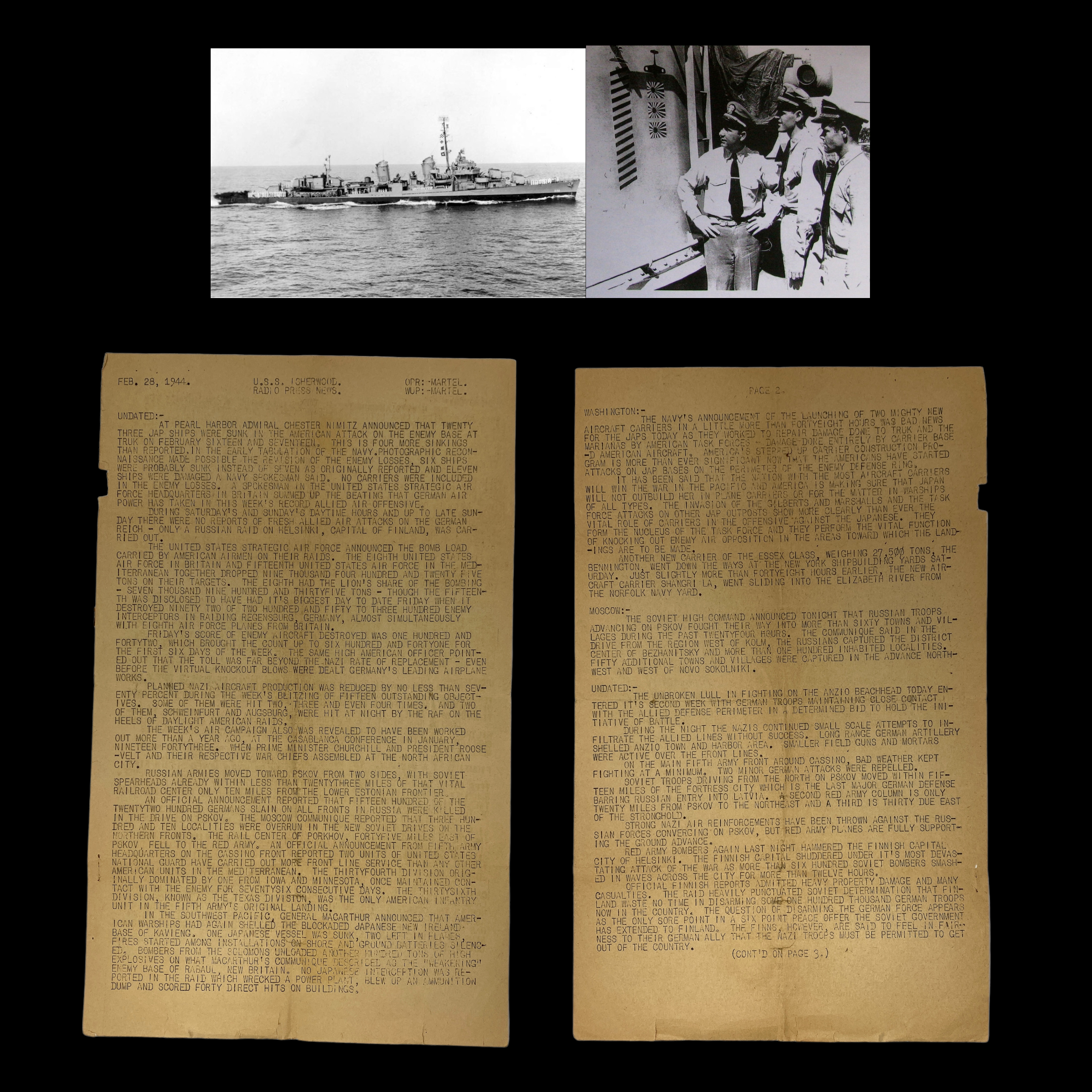

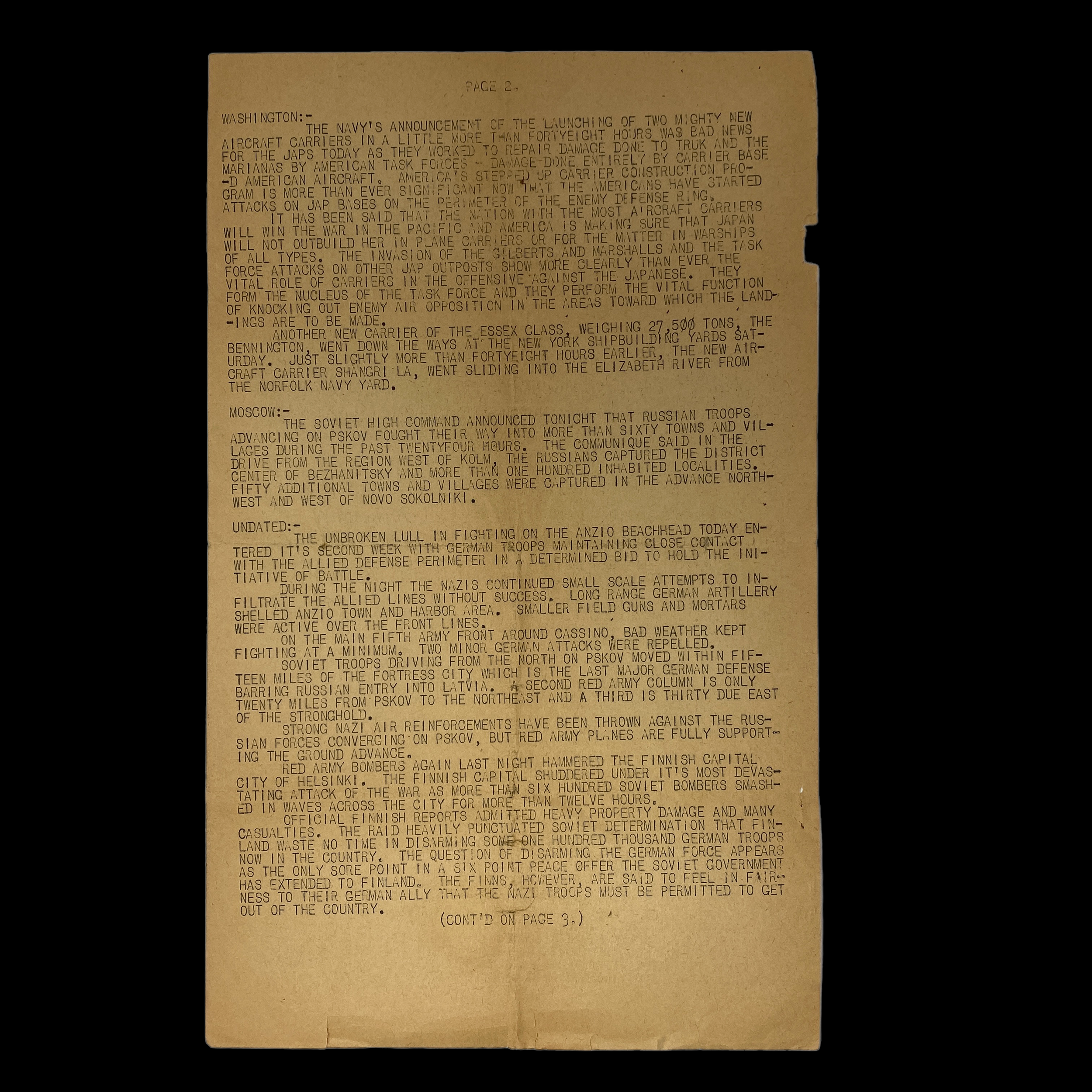
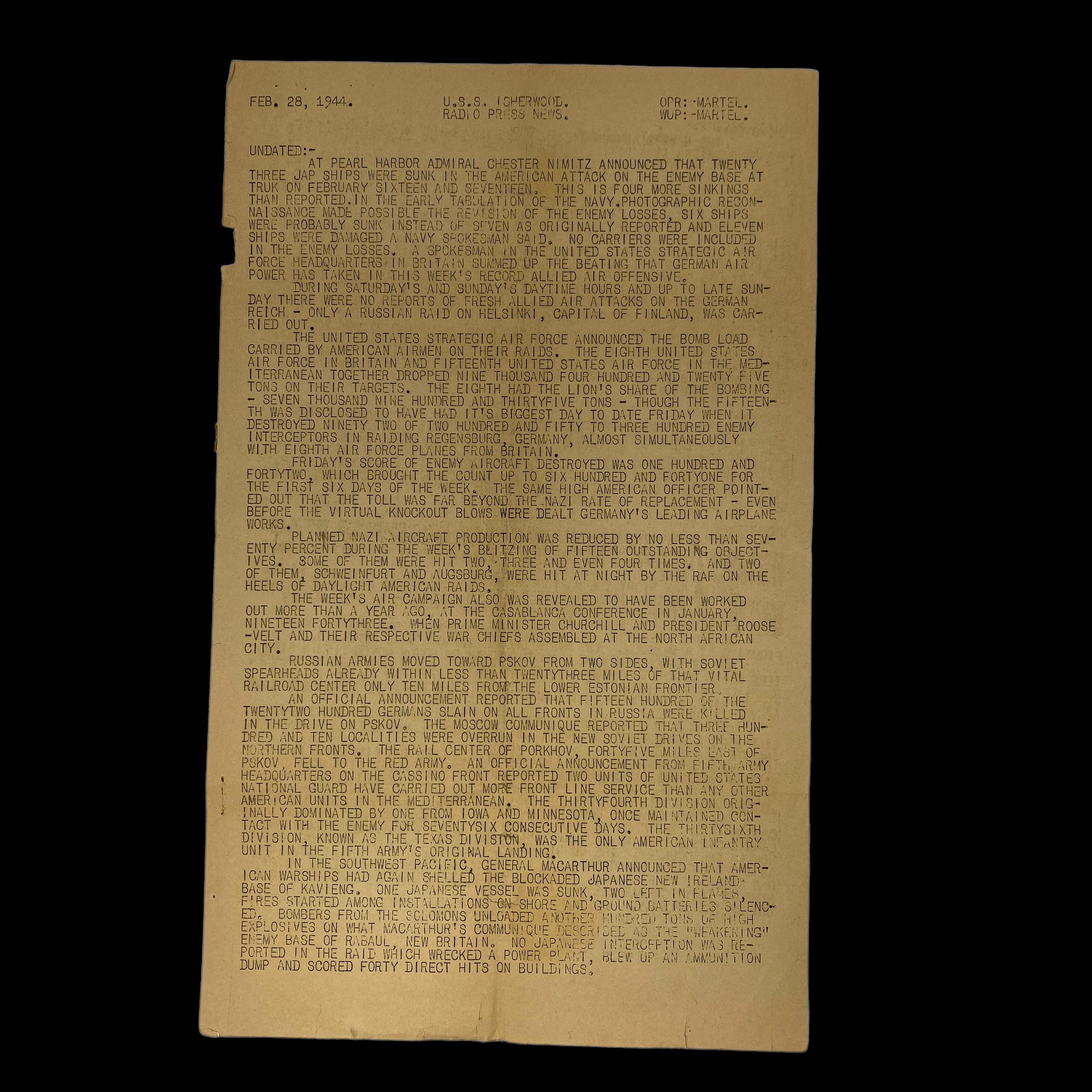
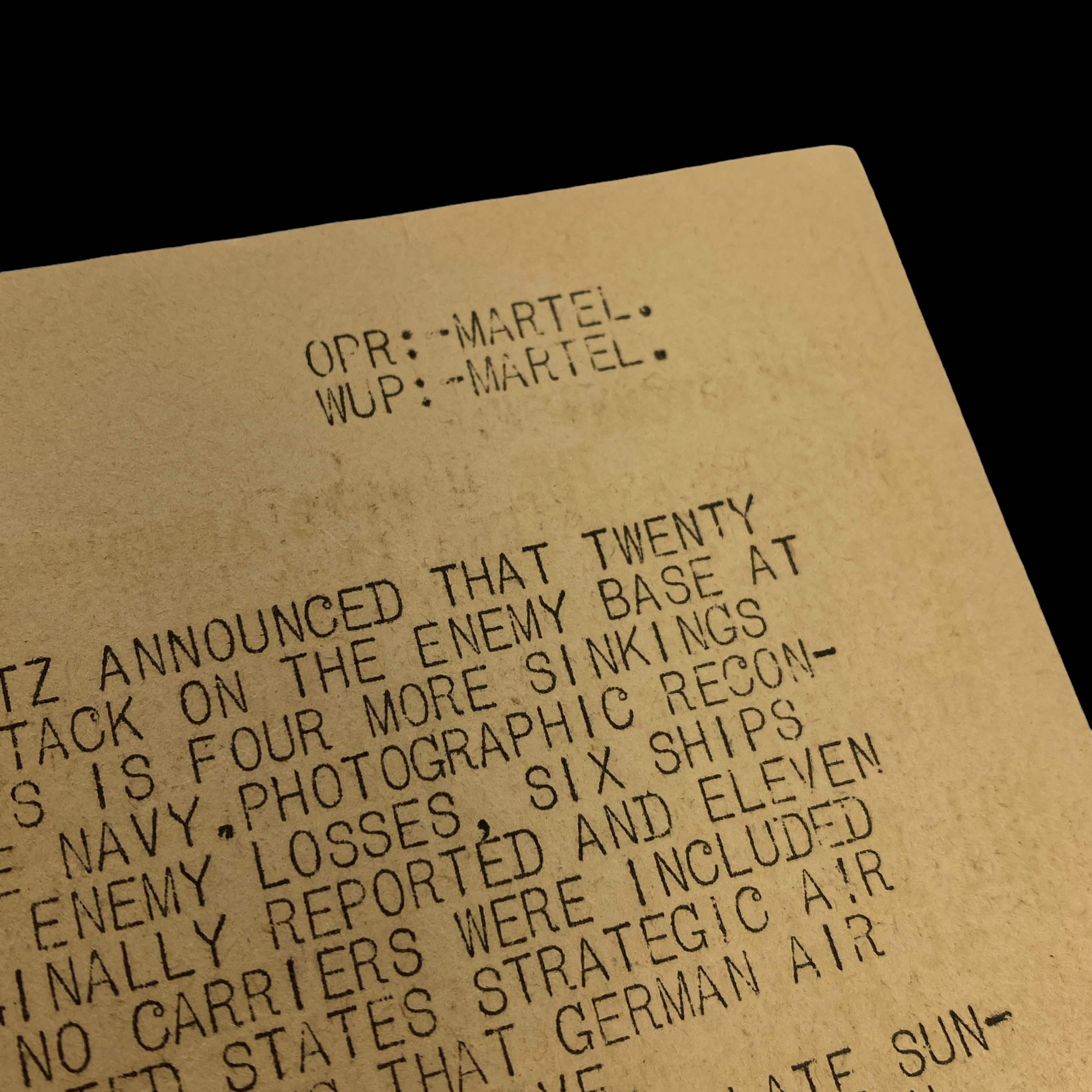
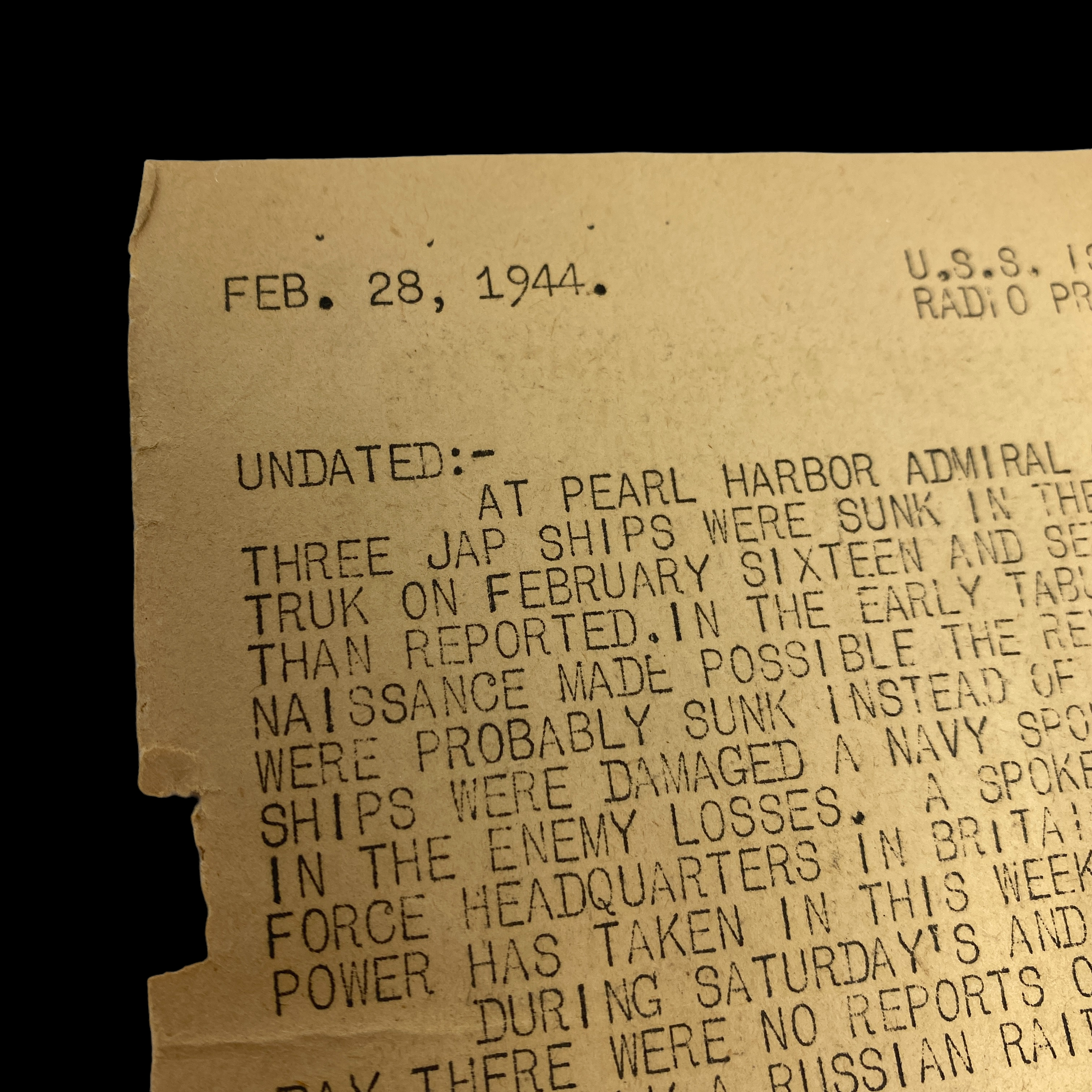
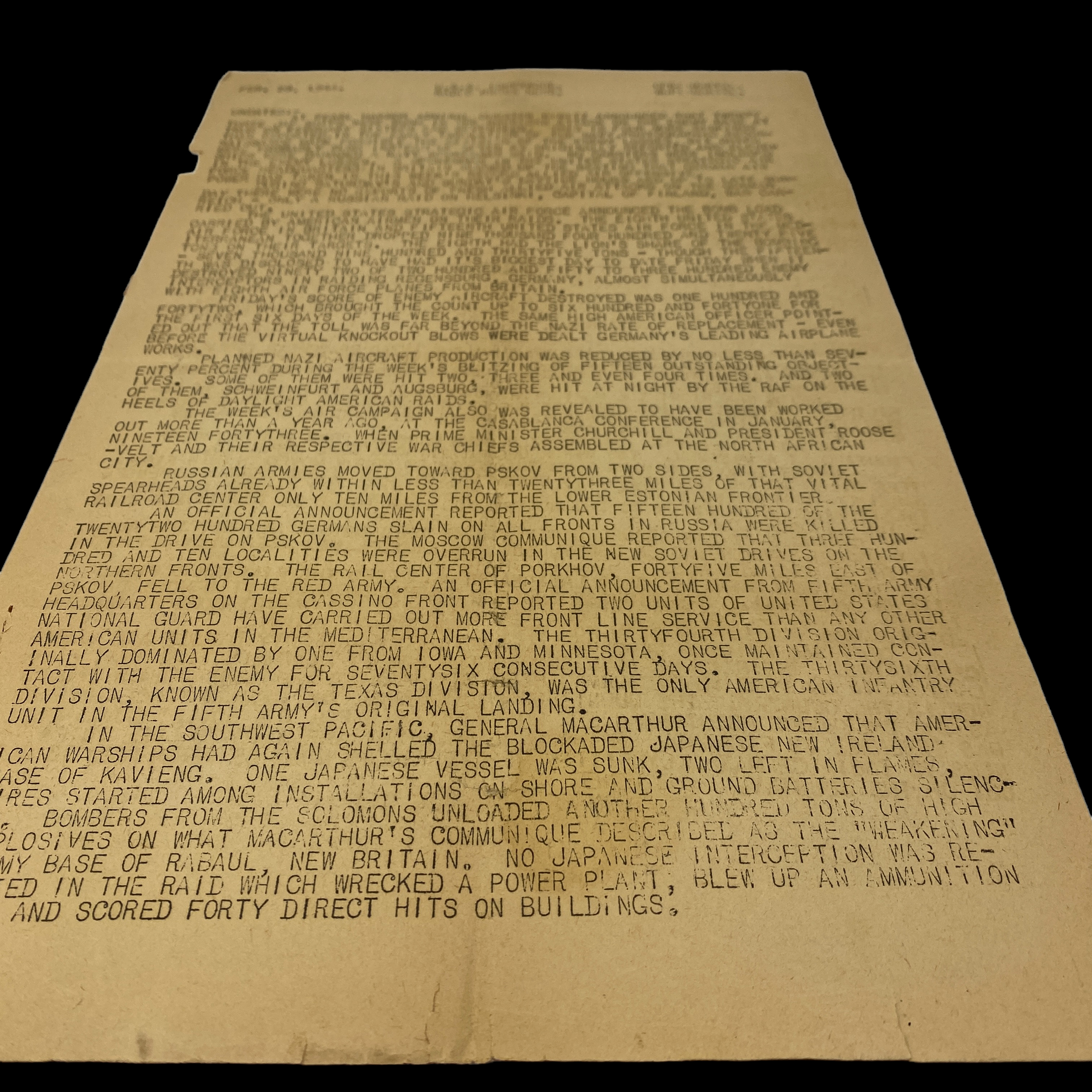

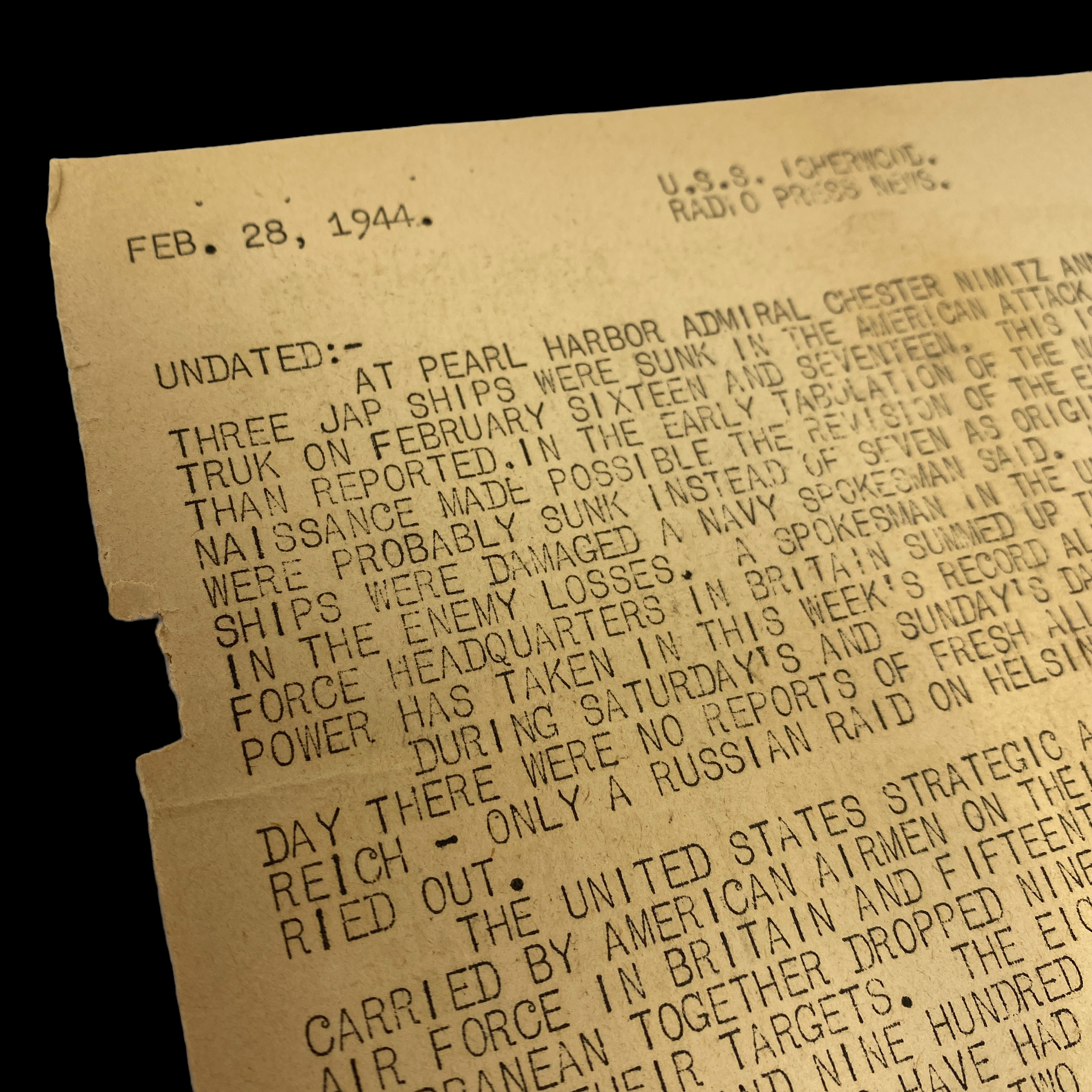


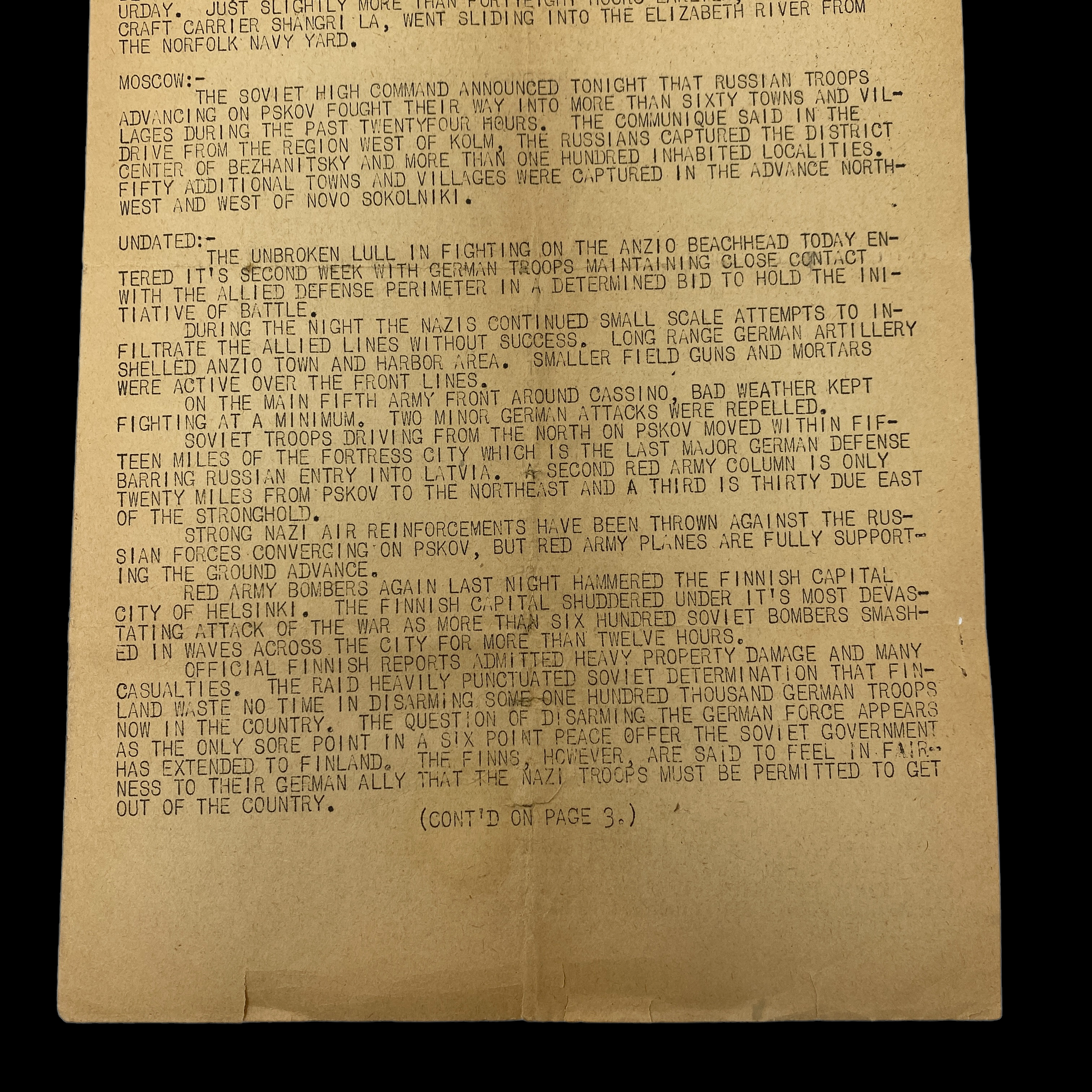
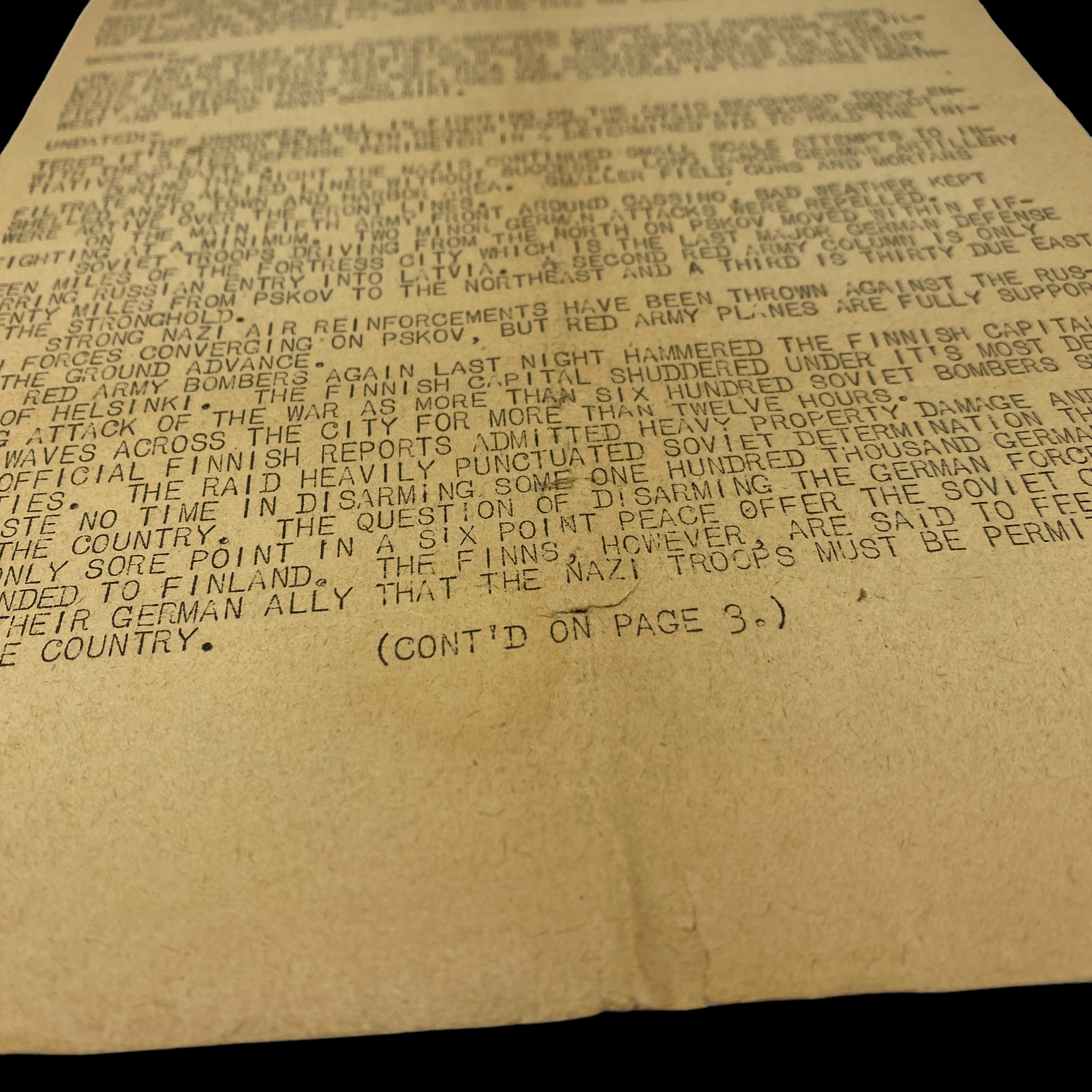




RARE! WWII February 1944 USS Isherwood (DD-520) USN Destroyer Combat Intelligence Report
Comes with a C.O.A. and a full historical write-up.
This incredible and museum-grade WWII USS Isherwood (DD-520) double-sided combat intelligence report is dated February 28th, 1944. Destroyer Isherwood (DD-520), a veteran of 14 island invasions was no stranger to combat during WWII, this radio room report was printed on the USS Isherwood and was meant to provide the officers and crew of the USS Isherwood with the most updated military intelligence in the Pacific and European Theaters. The specific combat intelligence report details, Admiral Chester Nimitz announcement at Pearl Harbor about the American victory and loss of 23 Japanese ships during the Battle of Truk. The report also extensively details, the aerial missions and combat efforts of the US eighth Air Force and 15th Air Force. This report details the success of multiple 8th Air Force missions and the reported losses and impact on German factories and wartime production. It also details General MacArthur's announcement of US efforts in New Ireland, Kavieng, and the Solomon Islands. What makes this intelligent report also very unique and rare are the combat intelligence reports of the Allied D-Day assault on the Anzio Beachhead.
This combat intelligence report would make an amazing addition to any World War II collection, and would look incredible, framed and displayed on the wall.
WWII Combat History of the USS Isherwood (DD-520):
USS Isherwood (DD-520), a Fletcher-class destroyer, was the second ship of the United States Navy to be named for Rear Admiral Benjamin F. Isherwood (1822–1915).
Isherwood was launched by Bethlehem Shipbuilding Co., Staten Island, N.Y., 24 November 1942, sponsored by Mrs. A. J. Kerwin, granddaughter of Rear Admiral Isherwood; and commissioned 12 April 1943 at New York Navy Yard.
The new destroyer conducted her shakedown training in Casco Bay, Maine, and off Guantanamo Bay, Cuba, through April and May. During the next 2 months she operated with a patrol and escort group out of NS Argentia, Newfoundland, and on 5 August 1943 departed for England with troop ship RMS Queen Mary. Isherwood arrived Scapa Flow 19 August to carry out combined operations with the British Home Fleet, including a search toward Spitzbergen for German battleship Tirpitz. Sailing 14 September, the destroyer returned to Boston with a convoy 29 September 1943.
Isherwood was subsequently reassigned to the Pacific, sailing from Boston 14 November for San Francisco. From there she steamed to Pearl Harbor and sailed 11 December to join Task Force 94 (TF 94) in the Aleutians. For the next eight months, Isherwood carried out antisubmarine sweeps of the cold Alaskan waters. In June she took part in bombardments of the Kurile Islands, finally arriving San Francisco for repairs 15 August 1944.
USS Isherwood (DD-520) and the Invasion of the Philippines:
Isherwood sailed for Pearl Harbor 26 August 1944 to take part in the long-awaited invasion of the Philippines, scheduled for October. She arrived at Manus on 4 October and steamed into Leyte Gulf with the assault force 20 October, carrying out escort and patrol duties during the first days of the operation. She also provided gunfire support and night illumination fire. Isherwood remained in the assault area during the giant four-part Battle for Leyte Gulf 23–26 October, in which the Japanese surface fleet was all but annihilated. During November the ship escorted convoys from advance bases to the Philippines in support of the buildup there.
The next major invasion of the Philippines campaign was to be at Lingayen Gulf. Isherwood joined Vice Admiral Theodore S. Wilkinson's Lingayen Attack Force at Manus, sailing 27 December. During the voyage through the islands from Leyte to Lingayen, the transport groups and carrier task groups were attacked incessantly by kamikazes, but even these desperate attacks could not stop the invasion. Isherwood shot down at least one suicide plane and assisted in splashing others before arriving the assault area 9 January 1945. She screened a landing craft group during the landing, sailing for Leyte with a returning group 11 January. During the last days of the month, specifically 29 and 30 January, the ship returned to Luzon to support the unopposed landings at San Antonio and Subic Bay, as ground units moved on Manila. Isherwood remained in the Philippines providing antisubmarine protection and patrolling until mid-March.
USS Isherwood - Combat Operation in Okinawa:
Isherwood sailed for the Okinawa operation 21 March 1945; and, after her arrival 5 days later, took part in the landings on Kerama Retto preparatory to the main assault on Okinawa. Troops from the main task force stormed ashore 1 April in the biggest amphibious operation of the Pacific war, and 2 days later Isherwood moved to a position off the beaches for fire support missions. This continued until 16 April, when the ship was sent to aid stricken destroyers Pringle (DD-477) and Laffey (DD-724) off Ie Shima. That afternoon she took over Laffey's duties as fighter director ship on picket station.
The days that followed found Isherwood in numerous heavy air raids, as the Japanese made a desperate attempt to drive off the invasion fleet with suicide planes. While on station 22 April a kamikaze made a dusk attack on the destroyer and crashed No. 3 gun mount. One veteran described the kamikaze pilot as: "a jockey riding in on a horse." Many fires were started by the D3A1 "Val" dive bomber and his 500-pound bomb, but all were quickly extinguished except the one in the depth charge rack aft. After 25 minutes of dangerous fire-fighting, the charge exploded, causing great damage in the after engine room. Isherwood arrived Kerama Retto with over 80 men killed, wounded, or missing.
Destroyer Isherwood (DD-520), a veteran of 14 island invasions, arrived off Okinawa on 26 March 1945. She actively participated in the initial pre-landing bombardments off Kerama Retto, remaining on station as troops from Tenth Army stormed ashore on 1 April in the biggest amphibious assault of the Pacific War. Two days later, on 3 April, Isherwood steamed with minesweeper Swallow (AM-65) and landing support craft LCS(L)(3)-15 to a position off the beaches of Ie Shima to provide fire support for ground forces fighting their way inland. The destroyer remained in this role until 16 April, after receiving orders to help fellow destroyers Pringle (DD-477) and Laffey (DD-724) off Ie Shima, both of which had been struck by kamikazes. Steaming to the area where Pringle’s crew were struggling against the currents for their own survival, Isherwood crewmembers helped their fellow “tin can” Sailors onboard. The grim tale of Pringle’s destruction, split in two before sinking, spread quickly around the ship, leaving many of Isherwood’s crewmembers shaken.
On the evening of 22 April, while still on radar picket duty, Isherwood’s crew finished the evening meal when a warning of an impending air attack sent men scrambling to their battle stations. Eagle-eyed lookouts spotted three Aichi D3A type 99 carrier bombers (“Val”) flying low towards Isherwood from off her port quarter. Weaving in an attempt to make it difficult for the destroyer’s guns to target them, the kamikazes closed in on Isherwood at an alarming pace. Torpedoman’s Mate Homer D. Stewart watched in awe as one of the Vals attacked the ship, recalling the enemy pilot, “looked just like a jockey riding a horse coming in on that plane.” The kamikaze continued its steep dive on the destroyer, prompting Lieutenant Commander Louis E. Schmidt Jr., commanding officer of Isherwood, to maneuver away from the Val.
Stewart later theorized his captain’s response inadvertently put Isherwood in the path of the kamikaze. Schmidt “tried to take evasive action. As a matter of fact, if he’d have turned toward the plane instead of away… it would’ve missed us.” At 1740, the kamikaze plowed into the No. 3 gun mount, wiping out most of the men stationed there, as well as the ammunition handling room. Stewart, manning a 20-millimeter gun just below the main deck, recalled the suicider caused the barrel of a 5-inch gun to flip over, smashing his own gun. Aviation gasoline “ignited around the depth charge next to us.” Realizing he had to put the fire out, the torpedoman’s mate grabbed a hose, voluntarily becoming the number one nozzleman. Suddenly, somebody grabbed Stewart by the shoulders and ordered him below, telling him, “I saw you get hit. You’re going to the wardroom.”
Fighting furiously to save Isherwood, damage control crews continued battling the fire threatening to reach the lone depth charge. A rescue ship coming alongside to offer assistance received a signal to stay away, while Schmidt deliberately remained outside Kerama Retto’s harbor, fearing an explosion onboard would damage other vessels anchored in the area.
Twenty-five minutes passed between the kamikaze striking Isherwood and the explosion of the depth charge. Only two minutes after arriving in the wardroom with several shrapnel wounds to his back, Stewart felt Isherwood shake violently. The blast turned the after engine room into a mass of twisted steel and “took out the next ten men on that hose when it blew up.” Stewart realized he would have been among the dead had he not been ordered below., with all fires put out and only her starboard engine functioning, Isherwood put into Kerama Retto, before steaming under her own power for Ulithi in May. She had suffered 42 men killed and another 41 wounded, and would not return to action for the remainder of the war. Transferred to a troop transport ship for treatment of his wounds, Stewart remained onboard a week before returning to Isherwood. Once safely back aboard the destroyer, he later discovered a Mitsubishi G4M twin-engine bomber (“Betty”) struck the transport shortly after he left. Told the enemy aircraft’s “burning wing went through the bed that was assigned to me,” Stewart explained his two recent near death experiences, proclaiming, “So that’s why I think that I have the Lord on my side. All the way.”